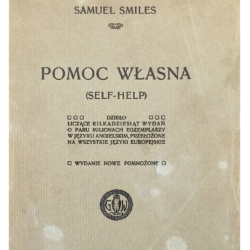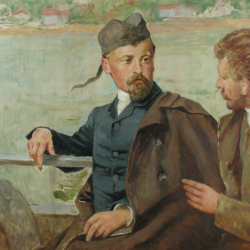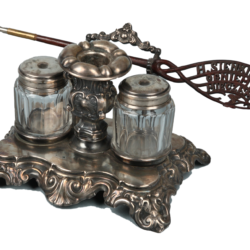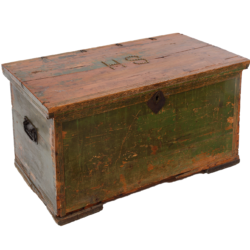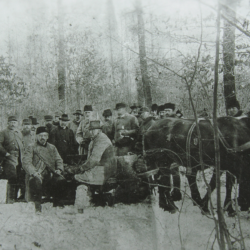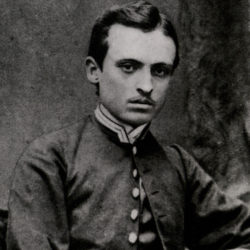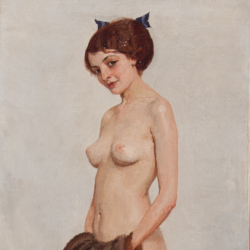
Hunt and Desire
At this point, we can pose the following question: is it not so that the hunts, which are so important in the construction of Szkice amerykańskie [American Sketches], also constitute a decent substitute of erotic experiences that are mentioned openly in private correspondence and that, analogically, confirm the masculinity of the narrator? According to the letter to Daniel Zgliński, written in San Francisco in May 1877, “Robinson’s life”, with the ever-present rifle in his hand, is supposed to be a wonderful remedy for frayed nerves, apathy and indecisiveness[1]. In one of the letters to Julian Horain, the companion of his American experience, we can find a very striking and clearly sexual metaphor, comparing sex to firearms:
And when I think that a man has sixteen thousand bullets, so I should still have around five hundred (an assumption proving my modesty), and that these five hundred bullets that nature seemed to have preserved for Matylda are lying useless and getting old, 15 miles away from Matylda, or even worse, they are shot in my sleep on Max Neblung’s bed sheets.[2]
In Sienkiewicz’s mind, hunting, masculinity and eroticism are often interconnected on the level of language also in Listy z podróży [Letters from the Trip…], although in a more veiled way – the model of masculinity, i.e. an ideal American man, is often compared to strong and dangerous animals: an eagle, a bull or “a lion in love” (p. 217)[3]. As a side remark, we may add that the author later uses the same kind of association, with a slightly weaker sexual undertone, when constructing the protagonists of Trylogia [Trilogy], who are compared to animals – the animal evoked matches the protagonist’s physique. As a result, Wołodyjowski is described as a wildcat, and Zagłoba as an ox[4].
The additional elements of the therapy that was administered to the European dandy included manual labor at the construction of a hut (the memories of which echoed back many years later, for instance in the letter to Stanisław Witkiewicz of January 13, 1881![5]), taking up carpentry, as well as self-imposed limitations and modest needs (the often mentioned “one-dollar pants”[6]). This was accompanied by shaking off social conventions (e.g. preference for honesty and simplicity over refinement) and, finally, a gradually more visible bent for travelling, identified with freedom (“I arrived in these mountains like a bird, and like a bird I am going to depart” – p. 220).
As befits a decent Entwicklungsroman, the survival training brought the desired effects – thus was created Litwos; in the woods, he could provide himself with food, shelter and safety. “The dream bison-hunting trip to Wyoming” turned him into an experienced hunter, who was offered the post of leader by his companions (which he politely refused – p. 295). He volunteered to take the first night watch; he looked after the camp with dedication, and humorously reported the slip-ups of his companions.
Sienkiewicz’s text seems to successfully realize Samuel Smiles’ recommendations on how to construct a mature man: aware of his aims and potential, able to evaluate the world critically and to adapt his actions accordingly, and simultaneously not deprived of youthful ardor. Experiencing such a process before turning thirty is part and parcel of the recommendations formulated in Self-Help or Character since, as Ewa Paczoska notes:
The exceptional nature of adolescence, the time of particular receptivity and sensitivity to new stimuli, consisted in building solid foundations of knowledge about the world, which would simultaneously constitute the basis for character-shaping. Smiles stressed the role of “youthful ardor” as “hopeful indication of character.”[7]
Przypisy
- “Can you imagine this wonderful, warm, and wooded country, where you travel on foot or on the horse back, live off your own rifle, you look at the money like the cock at the pearl, you sleep under the sky and near the fire, you forget about moral dilemmas, and you expend all your energy, all mental and bodily powers on not missing the target, such as some crappy partridge or a hare. If you can’t revive like this, you can’t at all. […] The game is plenty – I learnt to shoot like an angel. The sun has burnt my skin so that I look as if I were a Turk or an Indian. I lost weight because all my fat evaporated, but I got smoked, and I toughened, and I am as healthy as a horse. Having known me earlier, you wouldn’t believe how wild my life is for the bigger part now, but I give you my word that it is really so. I sleep well, I eat like a horse – I don’t worry about tomorrow. I light a bonfire, wrap myself in a quilt, and “all right”. When I recall the old silly fear, this vague anxiety that accompanied me when I went to sleep – just think about the satisfaction, the feeling of power and health when I sometimes tell myself, ‘I don’t give a shit about those nerves!’” (H. Sienkiewicz, Listy [Letters], vol. 5, part 2, edited, annotated, and with an introduction by M. Bokszczanin, Warsaw 2009, pp. 585–586).
- H. Sienkiewicz, Listy [Letters], vol. 1, part 2, pp. 365–366.
- Animal metaphors conquered the imagination of the author of Szkice amerykańskie [American Sketches] for a long time, also in other texts that were not meant for publishing. Referring to himself, Sienkiewicz used a whole series of such humorous similes in the letter informing his friend about his longed-for engagement: “Strange things are happening, my dear! I thought I could live perfectly alone, like a rogue animal in the woods, and I believed there was no other animal like me – such a skittish and bit-hating horse, such a kicking donkey, such a surly bear, and such a grouchy rhinoceros. It seemed to me that I was the most untamed and the most difficult to tame animal that zoology has ever heard of. And yet, I can see now that I am like a big faithful dog that could lie at my master’s feet and bristle up only when some evil approached the beloved hand. In a word: Orso growls quietly, and is very happy” (the letter to Stanisław Witkiewicz, as of 22 January 1881, in H. Sienkiewicz “Widziałem wszystko, com chciał i potrzebował widzieć.” W stulecie śmierci Pisarza wybór listów oraz pokłosie epistolarne [‘I Saw Everything That I Wanted and Needed to See’. At the Centenary of Death of the Writer. The Selection of Letters and the Epistolographic Legacy], in press, M. Bokszczanin, Warsaw 2016, pp. 177–178). In this letter, he also compared himself to “good Caliban” with fair-haired Miranda, who expresses his feelings and promises to take care of her in the wilderness (“I prithee, Let me bring thee/where crabs grow/And I with my long nails will dig thee pignut/Show thee a jay’s nest and instruct thee how/To snare the nimble marmoset …” (Shakespeare, The Tempest, act two, scene 2, lines 1253-56). The additional ambiguity and comic nature of these remarks is due to the fact that Shakespeare’s Caliban gives those promises to Stefano, a drunken sailor, with no romantic intentions.
- See M. Pietrzak, Językowe środki charakteryzowania postaci w twórczości historycznej Henryka Sienkiewicza [Linguistic Means of Protagonist Description in the Historical Works of Henryk Sienkiewicz], Łódź 2004.
- Oh my dear! Sometimes, I feel so bad in Warsaw! It’s even worse because I know very well what could make me feel calm, happy and be the king of infinite space. Sometimes, it seems to me that I am a squatter, carrying heavy beams to build a hut, and arranging them with difficulty. But I cannot be sure if on some beautiful morning, they don’t all fall down on me, if I don’t lose my footing, and, when in doubt, I feel so exhausted and powerless.” (H. Sienkiewicz. Widziałem wszystko, com chciał i potrzebował widzieć… [I Saw Everything That I Wanted and Needed to See…], pp. 175–177).
- “My wardrobe, which consists of a flannel shirt, grosgrain trousers, and a sombrero, costs one dollar. The climate does not require anything above that.” (H. Sienkiewicz, Listy [Letters], vol. 3, part. 2, pp. 452–453).
- E. Paczoska, op. cit., p. 33 (chapter: “Dojrzewanie – problem percepcji” [Growing-Up – the Problem of Perception]. The quotation comes from Smiles’ book, entitled Character, London 1831, p. 347.

